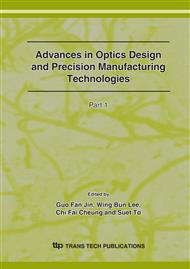p.649
p.655
p.662
p.668
p.674
p.680
p.686
p.690
p.696
Design of Sword-Form Electrode and Ultrasonic-Aid in Electrochemical Finishing of AISI 4340 Surface
Abstract:
It is difficult to execute the polishing process for swords surface. This study provides a design of sword-form electrode and a new area finishing process using an ultrasonic energy transmitted into the electrolyte to assist the process of electrochemical finishing on the surface of nickel chromium steels beyond traditional polishing process of sword surface instead of the conventional hand or machines surface finishing. The surface of the sword is electrochemically finished by different types of feeding electrodes as a finishing operation. In the experiment, four types of electrode were used with continuous direct current and axial electrode feed applied. The controlled factors included the chemical composition and concentration of the electrolyte, die material, initial gap width, and flow rate of electrolyte. The experimental parameters were current rating, feed rate of electrode, frequency and power level of ultrasonics, and electrode geometry. The higher current rating with ultrasonic assistance can avoid the difficulty of dregs discharge, thus reducing the finishing time. For the design of electrodes, an electrode of arc-end shape with small end radius and small wedge angle provides larger discharge space and better finishing effect. The electrode of round-pin shape with semicircular end is associated with higher current density and provides more opening discharge space and performs best. A low-cost and effective finishing process of the sword surface is presented. It is a great contribution that the ultrasonic-aided electrochemical finishing after sword finish just needs quite a shorter time than manual or machine polishing to make the surface of swords smooth and bright.
Info:
Periodical:
Pages:
674-679
Citation:
Online since:
December 2007
Authors:
Price:
Сopyright:
© 2008 Trans Tech Publications Ltd. All Rights Reserved
Share:
Citation:


